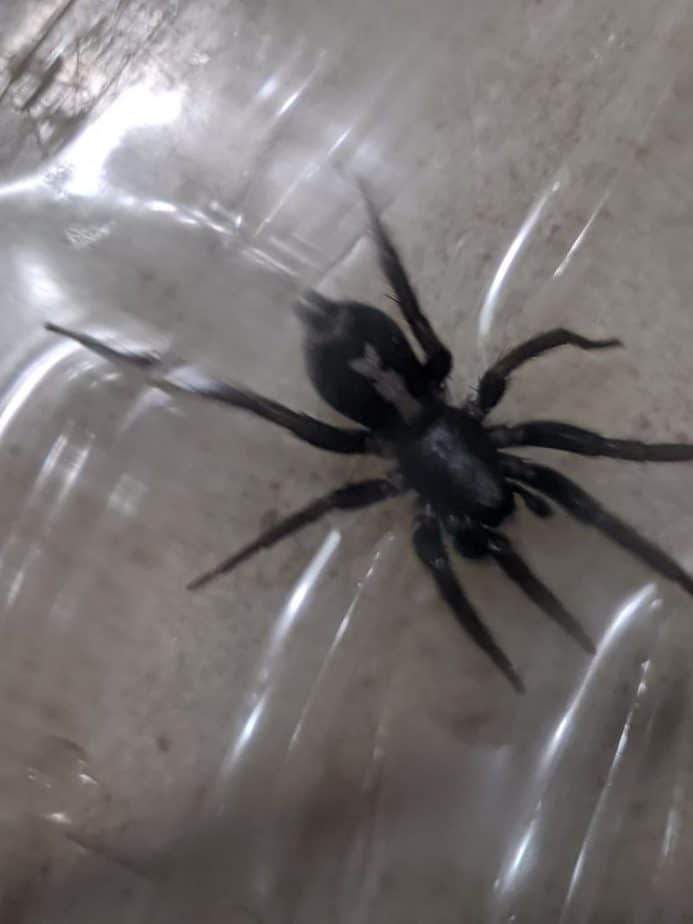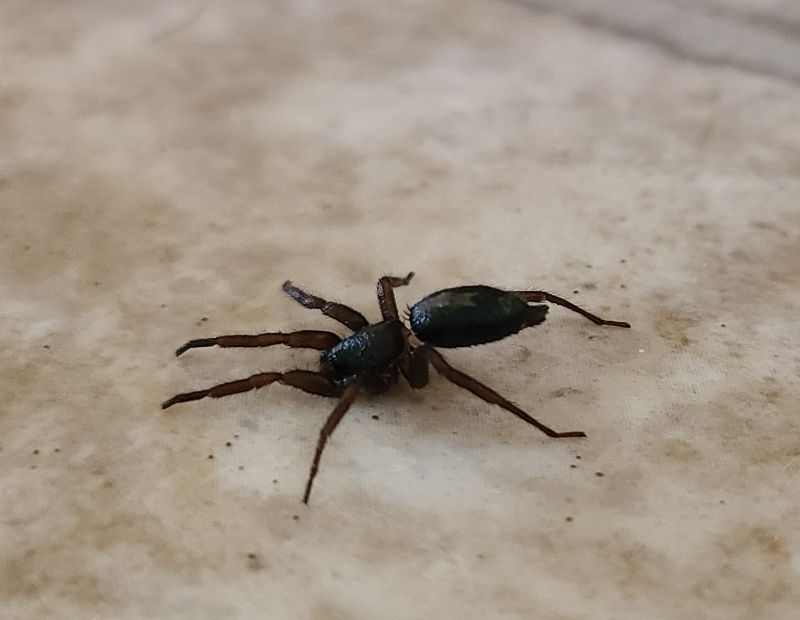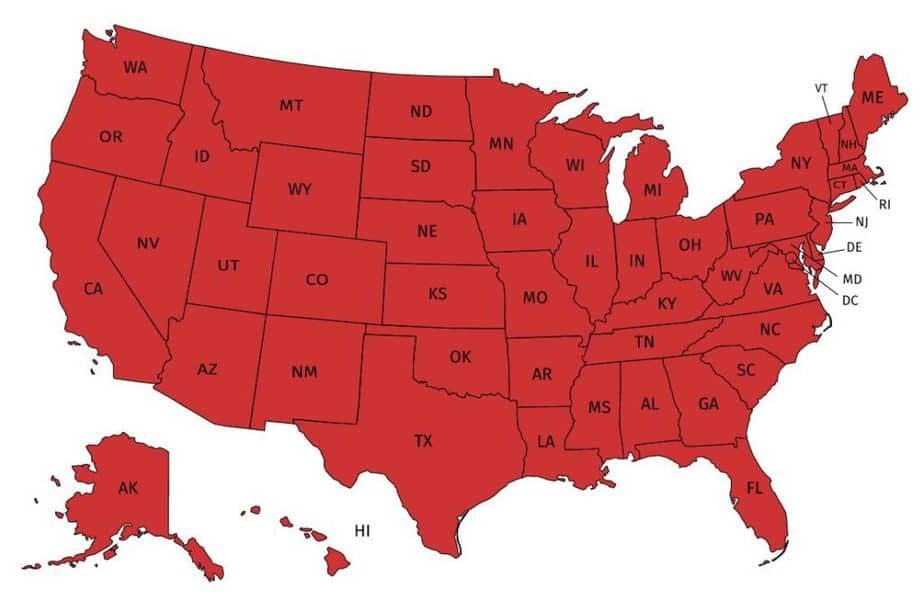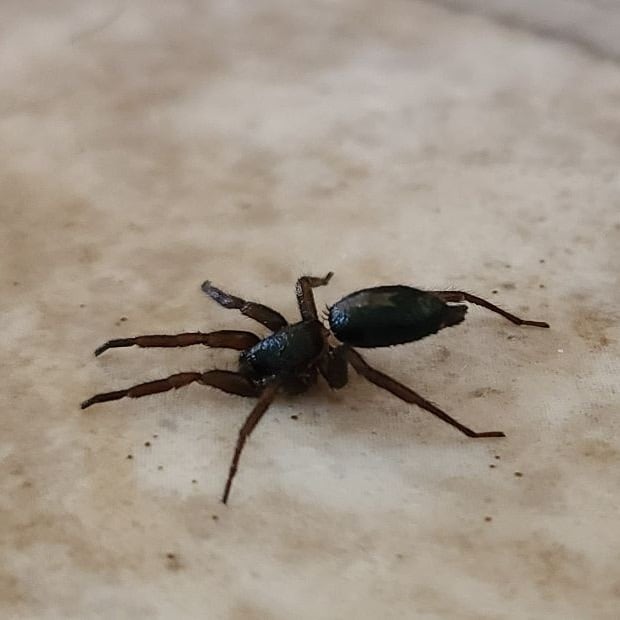Herpyllus ecclesiasticus, The Eastern parson spider is one of the most commonly encountered hunter spiders in the United States. The largest share of its population occurs in the Eastern part of the American continent but today, the Parson spider is native in every U.S. state.
Eastern Parson Spider Description
Its name “Parson” is not derived from a scientist who devoted its life to arachnids but rather to a distinctive characteristic of the Eastern parson spider. A white or gray marking on the abdomen of the predominantly dark brown black spider bears similarity to a traditional neckband worn by catholic clergy in the past. The entire body of the spider is covered with short hairs and the legs often have a reddish-brown color. On the back of the abdomen there are two short spikes, similar to those of the grass spider.

The parson spider is mostly found outdoors and lives under rocks or wood. It usually hides throughout the day and starts hunting at nighttime. During the winter months, the spider is more often seen inside of houses where it is seeking shelter from the cold.
Size
An adult female Eastern parson spider reaches a body length of 0.4 to 0.8 inches (10-20 mm). The male is, as is true for most spider species, smaller than the female.

Herpyllus ecclesiasticus Web
The parson spider is a hunter spider and does not create a web to catch its prey. It hides throughout the day and roams around at night looking for smaller insects to prey on. It can move fast and is a rather aggressive spider. Its silk glands are only used to produce an egg sac for the offspring.
Eastern Parson Spider Bite
Eastern parson spiders are quick and rather aggressive spiders. If they feel trapped, they don’t hesitate to bite. A bite is usually quite painful and can cause allergic reactions to sensitive people. However, it is not considered a medically significant species and normally, the somewhat intense initial pain diminishes rather quickly.
Distribution of the Eastern parson spider in the USA

The Eastern parson spider can be found in every U.S. state. As its name suggests, it occurs more commonly in the Eastern part of the United States. Alabama, Alaska, Arizona, Arkansas, California, Colorado, Connecticut, Delaware, Florida, Georgia, Hawaii, Idaho, Illinois, Indiana, Iowa, Kansas, Kentucky, Louisiana, Maine, Maryland, Massachusetts, Michigan, Minnesota, Mississippi, Missouri, Montana, Nebraska, Nevada, New Hampshire, New Jersey, New Mexico, New York, North Carolina, North Dakota, Ohio, Oklahoma, Oregon, Pennsylvania, Rhode Island, South Carolina, South Dakota, Tennessee, Texas, Utah, Vermont, Virginia, Washington, West Virginia, Wisconsin, Wyoming
Herpyllus ecclesiasticus Scientific Classification
- Kingdom: Animalia
- Phylum: Arthropoda
- Subphylum: Chelicerata
- Class: Arachnida
- Order: Araneae
- Infraorder: Araneomorphae
- Family: Gnaphosidae
- Genus: Herpyllus
- Species: Herpyllus ecclesiasticus


Mostly black with a few lighter markings, found in Fairfax, VA
Hello Heather,
This is an Eastern parson spider: http://usaspiders.com/herpyllus-ecclesiasticus-eastern-parson-spider/
It can be quite an aggressive spider with a painful bite – watch your hands 🙂 other than the initial pain, the bite is not medically significant and does not have any long-term effects.
Let us know if you have any questions
Thank you! That’s what I thought, but wasn’t sure. It was released outside without incident. 🙂
Found this black spider with unique white markings on its back in my house in South Windsor, Connecticut. It most closely resembles a grass spider from what I’ve been able to find, but doesn’t have a pointed abdomen and its body and legs are a strong matte black, while grass spiders seem to be lighter in color. Would love to know what it is.
Oh, and the twine is about 1/8″ in diameter, for scale.
Hello Heather,
Thanks for getting in touch. This is an eastern parson spider (Herpyllus ecclesiasticus):
https://usaspiders.com/herpyllus-ecclesiasticus-eastern-parson-spider/
Yes, that’s it! Thank you very much, learned something new today.
Found on the porch in north Florida
Can you identify this spider, found indoors in Northern Michigan on April 17.
What kind of spider is this
Any idea what this is? I found it in my home in NH
this spider crawled under my dryer a couple times,,,wasnt sure if i saw something or not…today i was spraying some bleach water for the dampness on the concrete and it came out…tried to get a photo because i noticed these markings on the back and just want to know if its poisonous or not..i dont like to kill spiders unless i have to …im in CT..its black with these tan colored bracket looking marks like [ ] sort of…im uploading the best i could do for a photo since it crawled under my ironing board against the wall in a tight spot. i think ive seen them before here and there in the house but dont recall the markings.thanks if anyone can tell me
I just took this picture of this spider on the wall of my garage. Never seen one before…. I live on Vancouver Island, British Columbia, Canada. So It has now moved into westren Canada folks……
Hello Cori, thanks for getting in touch! This is not a parson spider – it’s most likely some kind of trapdoor spider, possibly Ummidia species. It’s not one of the medically significant spiders: https://usaspiders.com/ummidia-trap-door-spider/
I find this kind of spider pretty often in my home in St. Paul, MN. This one is small, maybe the size of a penny, but the one I find most of the time are are bigger I’d say around the size of a quarter.
Hello Elizabeth, thanks for getting in touch! The size and the white/gray pattern on the spider’s abdomen suggests that this is an eastern parsons spider (Herpyllus eccleclasticus): https://usaspiders.com/herpyllus-ecclesiasticus-eastern-parson-spider/
It’s not a medically significant spider.
Find these types of spiders here & there in my apartment, they like the ceilings & corners but cannot for the life of me figure out what type of spider they are. No webs around the apartment, and the babies are so so tiny, like a nail on the wall is what they look like, the picture I have the spider is a little older, but we get much smaller ones around here
Found inside livingroom.size of a pennymaryland
Hello Rob, this is an eastern parson spider (Herpyllus ecclesiasticus): https://usaspiders.com/herpyllus-ecclesiasticus-eastern-parson-spider/
I live on North Dakota and Minnesota border, found this in my bathroom, no web. About the size of a nickel, legs included.
Hello Lori, this is an eastern parson spider (Herpyllus ecclesiasticus): https://usaspiders.com/herpyllus-ecclesiasticus-eastern-parson-spider/
Same spider
Hi. This spider lives in my bathroom and I’ve not seen a web. She doesn’t move a lot but when she does it’s pretty quick. Mostly she lives under my team soap dish/drainer thing and is about the size of a dime if you include the legs.
Hi Wendy, this is an Eastern parson spider (Herpyllus ecclesiasticus): https://usaspiders.com/herpyllus-ecclesiasticus-eastern-parson-spider/
It’s not a medically significant spider.
Found this little guy as I was cleaning out my kitchen never seen webs here just see them in my carpets crawling really fast. SA TX out in the country ish
Found in North Dakota on the kitchen table, just running around. Very fast running! Went thru the id questions but none had same pattern on the abdomen?
Thanks,
John
Hi John, this is a parson spider (Herpyllus sp.) – in your location, it could be an eastern parson spider (Herpyllus eccleclasticus) or a western parson spider (Herpyllus propinquus).
https://usaspiders.com/herpyllus-ecclesiasticus-eastern-parson-spider/
I found this guy crawling on my shoulder. Scared the stuffing out of me. This is in Sioux Falls, South Dakota. It is about the size of a dime, maybe a bit larger. It’s hearty, I grabbed it and threw it on the floor. Thought it was dead, but it straightened its crumpled legs and ran off.
Hi Gayle, this is a parson spider – they can be quite fast. Here is more information: https://usaspiders.com/herpyllus-ecclesiasticus-eastern-parson-spider/
This spider was found in our house in Plainville, MA. Can you identify the species? i have never seen one marked like this before.
IMG_2378
Hi Carol, this is a parson spider (Herpyllus eccleclasticus): https://usaspiders.com/herpyllus-ecclesiasticus-eastern-parson-spider/
I found this on my counter. Thought maybe an eastern parsons spider but doesn’t have the markings. Just two little white symmetrical marks on the abdomen.
Please help me identify the spider. It was found in Bozeman Montana
Hello Elizabeth, this is a parson spider: https://usaspiders.com/herpyllus-ecclesiasticus-eastern-parson-spider/
I have had these spiders in my house more than once I cannot figure out what kind of spider I live in Northern CA I have small children and live in the wooded parts of Humboldt is this spider dangerous to us
Hi Marissa, this spider is definitely not one of the medically significant spiders in your area. I can’t positively ID this one, I am leaning towards some type of sac spider.
From this far its hard to tell but looks to be a Parsons possibly.
Found this spider in my house. Is this a parson spider or some kind of wolf spider? The body and legs seem right but I have never seen those markings on the back before.